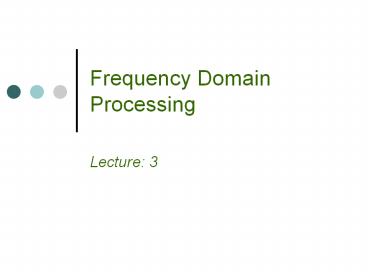Frequency Domain Processing PowerPoint PPT Presentation
1 / 36
Title: Frequency Domain Processing
1
Frequency Domain Processing
- Lecture 3
2
0. Overview of Linear Systems
- In image processing, linear systems are at the
heart of many filtering operations, and they
provide the basis for analyzing complex problems
in areas such as image restoration. - In this section we give a short review of linear
systems
3
0.1 Definitions
4
0.1 Definitions
5
0.1 Definitions
6
0.1 Definitions
7
0.1 Definitions
8
0.2 Convolutions
9
0.2 Convolutions
10
0.2 Convolutions
11
0.2 Convolutions
12
0.2 Convolutions
13
Frequency Domain Processing
14
1 The 2D Discrete Fourier Transform
- Let f(x,y) for x0,1,2, ..., M-1 and y1,2, ...,
N-1 denote an MN image. The 2D DFT of f is
given by - The frequency domain is simply the coordinate
system spanned by F(u,v) with u and v as
frequency variables.
15
1 The 2D Discrete Fourier Transform
- The inverse DFT is given by
- Thus, given F(u,v), we can obtain f(x,y) back by
means of the inverse DFT.
16
1 The 2D Discrete Fourier Transform
- The value of the transform at the origin of the
frequency domain that is F(0,0) is called the dc
component of the Fourier transform. - Even if f(x,y) is real, its transform is complex.
- The principal method of visually analyzing a
transform is to compute its spectrum that is the
magnitude of F(u,v).
17
1 The 2D Discrete Fourier Transform
- The Fourier spectrum is defined as
- The phase angle is defined as
18
1 The 2D Discrete Fourier Transform
- The polar representation of F(u,v) is defined by
- The power spectrum is defined as
19
1 The 2D Discrete Fourier Transform
- It can be shown that
- The DFT is infinitely periodic in both u and v
directions, with - the periodicity determined by M and N.
20
1 The 2D Discrete Fourier Transform
- Periodicity is also a property of the inverse
DFT. - An image obtained by taking the inverse DFT is
also infinitely - periodic in both u and v directions, with the
periodicity - determined by M and N.
21
1 The 2D Discrete FourierTransform
22
1 The 2D Discrete FourierTransform
23
2 Computing and Vizualizing the 2D DFT
- The FFT of an M N image array is obtained by
the syntax - Ffft2(f)
- and with padding by the syntax
- Ffft2(f, P,Q)
- The Fourier spectrum is obtained as
- Sabs(F)
24
2 Computing and Vizualizing the 2D DFT
- The funcion Ffft2 (f) moves the origin of
transform to the center of the frequency
rectangle. - Fcfftshift (F)
- Log transformation
- S2log(1abs(Fc))
- Function ifftshift reverses the centering
- Fifftshift(Fc)
25
2 Computing and Vizualizing the 2D DFT
- To compute inverse FFT
- fifft2 (F)
- If the imput used to compute F is real then the
inverse should also be real. However fft2 often
has small imaginary components resulting from
round-off errors. It is good practice to extract
the real part of the result - freal(ifft2(F))
26
2 Computing and Vizualizing the 2D DFT
27
3 Filtering in the frequency domain
- The convolution theorem
- Linear spatial convolution is by convolving
f(x,y) and h(x,y). The same result is obtained in
the frequency domain by multiplying F(u,v) and
H(u,v). - The basic idea in frequency domain is to select a
filter transfer function that modifies F(u,v) in
a specified manner. A transfer function is
multiplied by a centered F(u,v). - A filter is called low pass filter if it
attenuates the high frequency components to
F(u,v) while leaving the low frequencies
relatively unchanged.
28
3 Filtering in the frequency domain
29
3 Filtering in the frequency domain
- Example Linear spatial filtering.
- f
- 0 0 0 0 0
- 0 0 0 0 0
- 0 0 1 0 0
- 0 0 0 0 0
- 0 0 0 0 0
w 1 2 3 4 5 6 7
8 9
gimfilter(f, w, filtering_mode,
boundary_options, size_options)
30
3 Filtering in the frequency domain
gimfilter(f, w, filtering_mode,
boundary_options, size_options)
gtgt gimfilter(f,w,'corr',0,'full') g 0
0 0 0 0 0 0 0 0
0 0 0 0 0 0 0 9
8 7 0 0 0 0 6 5
4 0 0 0 0 3 2 1
0 0 0 0 0 0 0 0
0 0 0 0 0 0 0 0
31
3 Filtering in the frequency domain
- With specified values of P and Q we use the
following syntax to compute the FFT using zero
padding. - gtgt Ffft2(f, 7,7)
- F
- Columns 1 through 2
- 1.00000000000000
-0.22252093395631 - 0.97492791218182i - -0.22252093395631 - 0.97492791218182i
-0.90096886790242 0.43388373911756i - -0.90096886790242 0.43388373911756i
0.62348980185873 0.78183148246803i - 0.62348980185873 0.78183148246803i
0.62348980185873 - 0.78183148246803i - 0.62348980185873 - 0.78183148246803i
-0.90096886790242 - 0.43388373911756i - -0.90096886790242 - 0.43388373911756i
-0.22252093395631 0.97492791218182i - -0.22252093395631 0.97492791218182i
1.00000000000000 - .
- .
- .
32
3.2 Basic steps in DFT filtering
- Obtain the padding parameters P and Q.
- Obtain the Fourier transform with padding
Ffft2(f, P,Q) - Generate a filter function, H of size PQ. If the
filter is centered then use Hfftshift(H)
before using the filter. - Multiply the transform by the filter GH.F
- Obtain the real part of G greal(ifft2(G))
- Crop the top,left rectangle to the original
size gg(1size(f,1), 1size(f,2))
33
4. Lowpass frequency domain filters
- Ideal lowpass filter (ILPF)
- where D(u,v) is the distance from point (u,v) to
the center of the - filter.
34
4. Lowpass frequency domain filters
- Butterworth lowpass filter (ILPF)
- where D(u,v) is the distance from point (u,v) to
the center of the - filter.
35
4. Lowpass frequency domain filters
- Gaussian lowpass filter (ILPF)
- where D(u,v) is the distance from point (u,v) to
the center of the - filter.
36
1 The 2D Discrete FourierTransform

